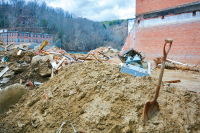Reclaiming a piece of history: Dillsboro leaders work toward making renovations to the historic Monteith farmstead, building a new park and community theater
By Sarah Kucharski • Staff Writer
Shoes stained with red clay mud and covered with sweat and bits of hay from a morning spent cleaning out the shed on the back of the Monteith property, Sam Hale leads a one person tour through the farmstead’s nearly century-old house pointing out artifacts along the way.
In the sitting room, there are the sawhorses, most likely made of chestnut, that were used to build the house in the early 1900s and were found out back. And to the right there’s the daybed frame, its original cornhusk mattress just recently thrown out due to bees.
In the kitchen, dishes are piled on the counter tops and pots stacked on the floor. The calendar on the wall is still turned to June 2001, the year that Edith Monteith, the last of the two sisters who lived on the farm, died.
The year seems too recent to match the contents of the house. Newspapers yellowed but still perfectly readable bear dates from 1908 to the 1940s. There are boxes of Victorian style boots with their soles worn.
“They didn’t know how to throw anything away,” Hale says with a smile.
Related Items
Hale has taken several artifacts home for safe keeping, as the house has been broken into and items such as a treadle sewing machine and thread stolen.
Regardless, the house remains a historian’s dream. The Monteith property is a rare example of an intact farmstead. Its house and all outbuildings — right down to the original outhouse — are still standing, each building in turn filled with family belongings, some dating back generations to the 1800s. Hale, a local who recently graduated from Western Carolina University with a double major in anthropology and U.S. history as well as a master’s degree in public history, has spent the past two years sorting through the Monteith’s history.
In some ways, the Monteith collection is almost comical — buckets of Pepsi Cola bottle caps old enough to still have cork for a seal, hundreds of canning jars, one leg from a wooden chair. In others, it provides an amazing quantity and quality of resources from which to learn about early Appalachian life, the town of Dillsboro and two truly independent women.
“There are very few intact farmsteads from that era,” said Scott Philyaw, director of the Mountain Heritage Center and an associate professor of history at Western. “What’s unusual about it is not just the house, but the stuff that was in it.”
The Monteith Preservation Committee is developing plans to turn the farmstead into the Appalachian Women’s Museum. The museum would detail the lives not just of the Monteith sisters, Edna and Edith, but also of other historical local women who have made significant contributions. Some of these include Gertrude Dills McKee, the first woman elected to the state Senate, and Daisy McGuire, a female dentist whose family still practices in Sylva.
However, there’s a long way to go — back through the past and into the future.
My sister and me
Elias Brendle Monteith, son of John Alfred and Sarah Brendle Monteith was born July 14, 1876, in Monteith Cove near Dillsboro. In 1907, at the age of 31 he married Mary Magdalene Carson, originally from Balsam. The couple built an American Foursquare farmhouse, a barn and several outbuildings on land from Elias’s father.
Elias served as Dillsboro’s postmaster and along with his brother, Sam, operated a mercantile store. He and Mary had two children, Edna and Edith. Edna never married and instead graduated from the Sylva Collegiate Institute, a Baptist-run Kindergarten through 12th grade school, in 1926 and followed in her father’s footsteps, beginning her career at the post office in 1928.
A dislike for marriage seems to have run in the family, as the story goes that Edith married, didn’t like it and after one day returned home to live the rest of her life with her sister.
“Even today that would be controversial,” Philyaw said.
After their father’s death, Edna became for all intents and purposes Dillsboro’s postmaster, although she never officially held the title and always referred to herself as a postal clerk.
She worked at the post office through three office moves — from near what is now Shirley’s Boutique, to another building on Main Street, and then finally to its current location near town hall — until 1973.
With 45 years at the post office Edna collected several postal records that shed light on who lived there, for how long, and so forth. These records, along with those the sisters held on to from their father’s mercantile store, which show tabs for items such as milk and butter, help flesh out the town’s history.
“We have their baby clothing, that’s how much they didn’t throw things away,” Hale said.
The sisters always were regarded as bit unlike the rest, most likely due to their independent nature and their lifestyle. Later in life the sisters had taken in several cats that lived in the shed. Flattened bags of Friskies cat food still litter the ground behind the house.
Of course, cats are a rather natural part of farm life and most likely helped keep the snake population down. Over the years the land had earned a reputation with the locals for being particularly snaky — the land is located near a creek and surrounded by kudzu. But Edith at least didn’t seem to mind the snakes.
“Edith had a pet snake sort of,” Hale said.
There was a small hole in a corner of the house where a snake came in and out. Edith would put out a platter of water for the snake to drink. The snake would come out, get a sip, and head back into the hole.
Farming for history
Restoration of the Monteith farmstead provides a unique opportunity to educate the public about Appalachian women. History tends to illustrate the Appalachian woman as a hardy, but subservient homemaker. Women like the Monteith sisters really broke the mold, but they weren’t alone.
“There were a surprising number of independent women at a time when at least stereotypically that was not the norm,” Philyaw said.
Creating a museum to honor these women would be a first of its kind. There have been exhibits, Philyaw said, but nothing permanent.
“I think there’s great potential for Dillsboro not only to document and educate about the role of women in Southern Appalachia at the time, but it’s a real tourist draw,” he said.
The restored Monteith house turned museum will be part of a 14-acre overall park development. The tract’s development was planned as a way to expand limited town parking. McGill Associates’ drawings for the tract show parking for 130 cars. The lot will be graveled this fall, with paving and other basic infrastructure to be put in this spring, said town manager Herb Nolan.
The town received a $250,000 grant from the Parks and Recreation Trust Fund to develop a public area to include horseshoe pits, a playground, and sand volleyball court. The grant was a matching grant; however, the Monteith property appraised in excess of the purchase price.
“So we’ve had to put up no cash,” Nolan said.
Additional funding has come from Duke Power, which gave $50,000 to be used for the project, as well as small amounts from Jackson County as part of the yearly municipal granting process.
No firm date has been set for project completion, Nolan said; however, the town is aiming for spring 2008 for the parking and recreation portion of the development.
Restoring the Monteith house is an addition to the plan for the property.
“When the town first bought the property they were given the impression that the house and all the out buildings needed to be torn down,” said Emma Wertenberger, former town board member and now part of the team working to restore the Monteith house.
A 2001 Sylva Herald story quoted Nolan as saying that the house was so infested with termites that it would be too costly to save, but that the farmstead’s barn might be an option for restoration. Once board members actually saw the house and its outbuildings, they saw that they were in better shape than expected, Wertenberger said.
The Monteith Preservation Committee is campaigning for funds to restore the farmstead for the museum, making it as interactive as possible.
“Our other equally important goal is to create educational opportunities,” Wertenberger said.
For example, the farmstead could be used for educational camps, field trips or hands-on study for local high school and college students.
Farms for the future
The Monteith farmstead is on the study list for the National Register of Historic Places.
“I would be shocked if they were turned down for the National Register,” Philyaw said. “It’s the social history of the house and that context that really I think would clench the National Register.”
The preservation committee has applied for grants — one through the History Channel, which they didn’t get, but will try for again and one through the Blue Ridge National Heritage Area.
“The best way to protect our heritage is not just preserving buildings and place artifacts in museums,” reads the BRNHA grant application. “The best way is to develop a preservation attitude. Facilitating discussions, educating the public and decision makers, and raising awareness can have a long term impact on preservation in the Blue Ridge area.”
Indeed, it takes nearly losing one’s history to provoke a sense of urgency to preserve what is left. The preservation committee is looking to involve students from Smoky Mountain High School in the restoration process, potentially passing down the appreciation for local history to yet another generation.









